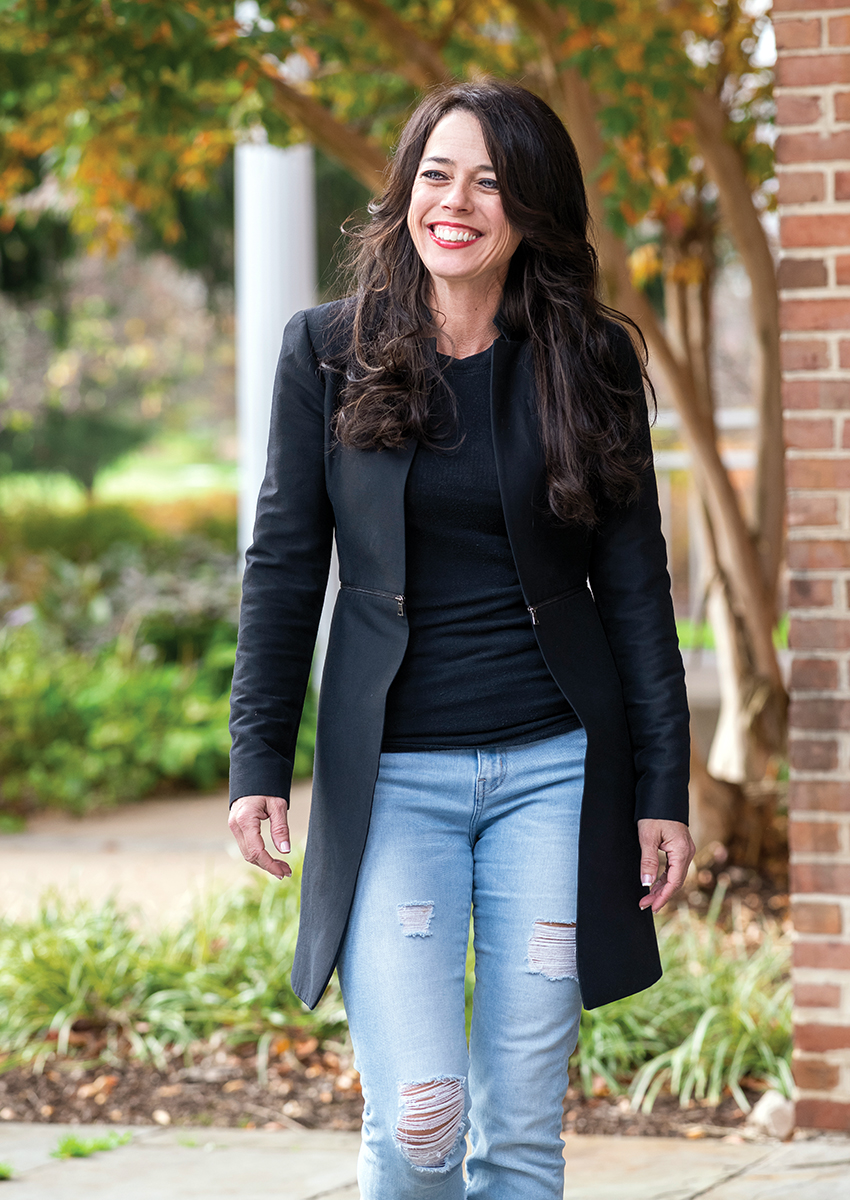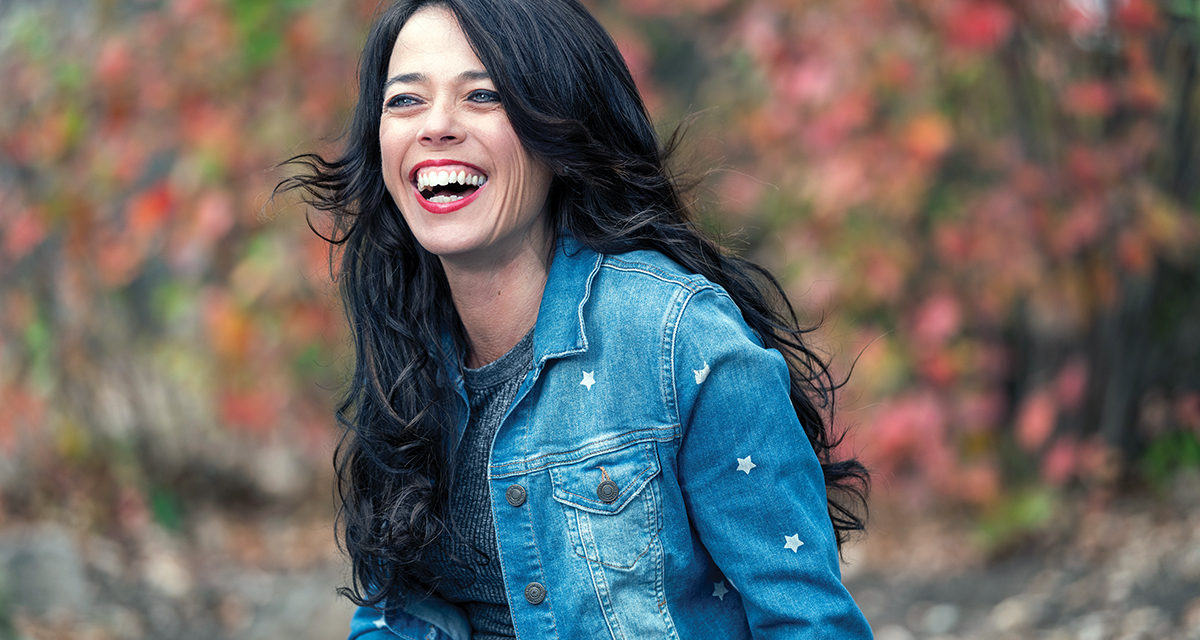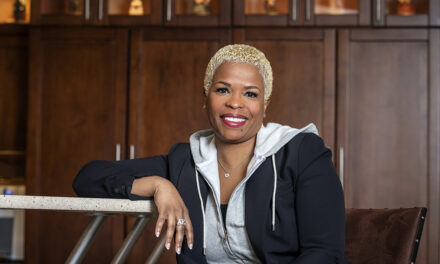Over the last 20 years, she has become one of the most important voices in funding blindness-related genetic research.
On the day that Kristin Smedley, 48, first encountered profound darkness, she felt her life was picture perfect. She lived in a beautiful home with her new baby boy when a doctor told her that the life she planned for her son wasn’t going to happen. He was blind. It was a shocking blow she didn’t see coming.
She had barely adjusted to that reality when the family was dealt a second hit.
She soon learned that just 300 children in the United States share the genetic mutation that caused Smedley’s son, Michael, to be blind. And her second son, Mitchell, turned out to be one of them. Two of her three children—both diagnosed as legally blind when they were just infants—were born with Leber’s Congenital Amaurosis, the incredibly rare mutation in the CRB1 gene.
Discovered when both of her sons, Michael, now 20, and Mitchell, now 16, were just 4 months old, Smedley says the prospect of a lifetime of blindness for them was one of the hardest things for her to accept. “Their blindness broke me,” says Smedley, a former third grade teacher who is also the mom of a daughter, Karissa, now 15, who doesn’t have any vision issues; nor does anyone else in the family. “I was the mom who was a mess for 3 years. I put on a happy face during the day and was a disaster at night.”
Smedley had no frame of reference for blindness. “All I knew about blindness is that it would be lonely, isolating, and devastating.
It was ultimately a group of other women who helped pick Smedley up and helped her realize all that she could do to advocate for her boys. “The first woman I met was a doctor who connected me to a group of parents in a similar situation,” she says. “Those parents started getting me off the couch. They were my tribe and they were the ones who urged me to get the tools my boys would need to not only survive but thrive.”
She took charge when they were learning Braille (including getting them an electronic Braille writer for all of their schoolwork and reading). She also got them iPhones that have a “voiceover” feature that reads the whole screen to them and white canes to navigate independently. She also “Braille’ed” all the family board games so the boys could play. In addition, she added Braille signs to the microwave and oven as well as on snack containers in the pantry. And she always put the boys’ cups and plates in an accessible place so they could serve themselves.
However, the biggest lesson Smedley learned was to give her boys agency in their own lives as often as possible. “I let Michael and Mitchell navigate and made it my role to walk beside them,” she says. “I don’t wish blindness or adversity on anyone, but I’ve learned that it’s not your job to direct your kids. It’s your job to guide them and
to be there for them.”
Thanks to her unwavering support—and to the determination of both boys—Michael is a stellar student at Pennsylvania State University and Mitchell is a high schooler who is training to compete in the Paralympics. Both are high-achieving students and International Braille competition finalists.
I don’t wish blindness or adversity on anyone, but I’ve learned that it’s not your job to direct your kids. It’s your job to guide them and be there for them.


Parenting Blind Children
1. Bet on Braille. In a world where nearly every written word can be accessed via audio (and it is usually cheap and easy to do so), Braille remains the #1 skill my boys learned at a very young age to keep up with and eventually surpass their sighted peers. With Braille, they learned the mechanics of our language—grammar, spelling, and punctuation—that you just don’t get with audio.
2. The white cane creates independence. I freely admit I was beyond uncomfortable with the white cane initially. But I now know it is the tool that most helped my boys navigate the world on their own.
3. Social skills take effort. I taught my sons to shake hands and look people in the face when talking/listening to them. Since they miss visual cues like eye rolling, cringing, or winking when interacting with peers, I had to teach them to listen for voice inflections to indicate nonverbal clues.
4. Go with team sports. My sons engaged in blind sports programs beginning at about 5 years old, and that gave them the foundation to move to sighted sports. Being on a team, they learned so many crucial social skills alongside other children.
5. Hands-on experiences help. From very early on, my boys traveled a lot, which encouraged them to have experiences beyond their restrictive worlds.
6. They have to advocate for themselves. Since third grade, my sons have been a part of their Individualized Education Plan (IEP) team meetings. By senior year in high school, they ran the entire meetings. They had to learn to coordinate assistance and brailled materials with their teachers from middle school onward. This empowered them and proved to be invaluable.
7. Technology is improving. Assistive technology and regular tech improve every year. By third grade, my kids used electronic Braille note takers. They had iPhones and iPads earlier than most kids because those devices have accessibility built in. Technology makes so many more things easier in terms of leveling the playing field with sighted classmates/peers.
8. They can help, too. Kids with disabilities tend to be on the receiving end of a lot of help/support. My sons needed to understand that they can contribute to helping others as well. They have managed fundraisers for nonprofits and volunteered their time for years.
9. Self-confidence is key. It was confidence that they tapped into to run for student government, take on a tough academic schedule, and go to college a thousand miles away.
10. Have a sense of humor. We have to laugh off so much ignorance and rudeness from the world every day. Many of the obstacles we face are a lot easier to tackle when we are laughing instead of complaining.
Finding Her Calling
While helping her children navigate life was her North Star, raising money and awareness to help find a cure to Leber’s Congenital Amaurosis became her mission, and she found the work transformative. What began as managing a Facebook group for other families dealing in similar circumstances became something much bigger in 2011.
That’s when she began talking to researchers who were studying a different gene mutation related to blindness. “They had just started making progress with their research,” she says. “I point-blank asked them, ‘How do I get you to do research on
my sons’ gene mutation?’”
She was told that the first step is to find researchers and, in tandem, raise $100,000 to fund the research. Undeterred, she did just that: In 2011, she founded the Curing Retinal Blindness Foundation, the only organization in the world dedicated to this disease and launched a website. “At that point, I had connected with 10 moms on Facebook,” she says. Armed with just a few personal stories and a donate button, Smedley went to work, and since that first a-ha moment when she realized she could begin taking steps towards finding research that had a goal of ultimately finding a cure for her sons’ blindness, she has raised $1.4 million. The foundation also submitted the first legislation in U.S. history in Braille (and it’s this legislation that advocates for better resources for blind and visually impaired Americans).
The foundation’s focus: To fund CRB1 research that focuses on gene therapy and moves towards a cure as quickly as possible. “At this point, I realized I was fully on a mission,” she says. “After all, how could I sit there knowing about all the other genes that were being looked at in clinical trials and not do something about the ones affecting me sons and all these other families I had gotten to know?”
Along the way, Smedley has had other incredible moments, including being one of 12 people to be invited to testify before the FDA. Her goal during her testimony: To explain the cost of raising blind children and equipping them with all the tools they need.
In addition, she and her family have been featured in a Comcast campaign to spread awareness about the company’s accessible platform (the ad prompted over 1.1 million views on YouTube) and it’s a technology the family uses due to its voice command remote and talking channel guide.
Smedley and her family also created and managed Bike the Basin, held in their hometown, which includes a morning of youth cycling and volunteering and has ultimately raised nearly $500,000 for the foundation.
In 2016, Smedley’s blog that focuses on how to change people’s perceptions of blindness began to reach internationally, a feat that was followed by a TEDx talk she delivered in 2017 on setting extraordinary expectations. And just this year, she published a book called Thriving Blind: Stories of Real People Succeeding Without Sight.
Smedley credits her own parents for her dedication to her family and for understanding the importance of living a life of service. “I think it’s in my DNA to help others because of how I was raised,” she says. “I had four brothers, and my parents didn’t have a lot, but they put us in the best schools they could afford, they ran our youth groups, and they were living in service to others all the time.”
Leaps and Bounds
These days, Smedley marvels at all that her sons have accomplished: Michael is on the Dean’s List, formed a band, and recorded an album, and Mitchell loves being in front of a camera and working a sound board for events. Smedley always finds time to cheer at her daughter Karissa’s field hockey and basketball games, all the while remaining laser-focused on fundraising and raising awareness for CRBF.
She works 80 hours a week on this singular goal and has no intention of slowing down now that her work has gained attention and traction. She’s currently the Pennsylvania ambassador for the National Organization of Rare Disorders (NORD) and is focusing on building a patient registry for her nonprofit. “Working in the rare disease world is unbelievable challenging,” says Smedley who this fall added RARE Champion of Hope award-winner to her long list
of accolades.
“I was so excited I won this award but, by the time I got to California to receive it, I was so tired. Then I walked into this room with a thousand other people who are doing the same work I’m doing. When I told them I was tired, they said ‘go take a nap, we have this—and when you get up you will run alongside us.’ These other crusaders are the people who propel me to keep doing this important work—every day.”
Smedley is optimistic about finding a cure. “I think it’s absolutely possible within Michael and Mitchell’s lifetimes,” she says. “In the next 10 years, the vision field is going to look completely different. I met one child with another mutation recently who is six years old and, after his surgical procedure, was able to trade in his cane and no longer needs Braille.”
She also says her ultimate goal is to improve the science so that there’s an “option for a cure,” she says. “I will know when I’ve been successful when there is a cure available and it becomes extremely hard for a patient to decide to take the cure or not. No matter what their decision is, we will remain committed to equipping them with every resource they need to live as a blind person.”
And, when told she sure sounds like a crusader, Smedley took a deep breath before responding. “I spend my days with other crusaders,” she says. “I’ve learned over the years to choose the right people to work with to meet my goals. That’s truly where I get my drive.”






